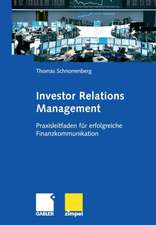The Theory and Practice of Corporate Communication: A Competing Values Perspective
Autor Alan T. Belasenen Limba Engleză Paperback – 3 oct 2007
Preț: 983.20 lei
Preț vechi: 1346.85 lei
-27% Nou
Puncte Express: 1475
Preț estimativ în valută:
188.19€ • 204.49$ • 158.19£
188.19€ • 204.49$ • 158.19£
Carte tipărită la comandă
Livrare economică 21 aprilie-05 mai
Preluare comenzi: 021 569.72.76
Specificații
ISBN-13: 9781412950350
ISBN-10: 141295035X
Pagini: 304
Dimensiuni: 178 x 254 x 11 mm
Greutate: 0.49 kg
Ediția:1
Editura: SAGE Publications
Colecția Sage Publications, Inc
Locul publicării:Thousand Oaks, United States
ISBN-10: 141295035X
Pagini: 304
Dimensiuni: 178 x 254 x 11 mm
Greutate: 0.49 kg
Ediția:1
Editura: SAGE Publications
Colecția Sage Publications, Inc
Locul publicării:Thousand Oaks, United States
Recenzii
"His framework for CC's "system and goals" has "innovation, information, regulation and integration" in the four quadrants, with associated words "transform, perform, conform, and reform", to answer important questions...a book that can add pep to the hassled in "corp comm"!"
—Businesslike
—Businesslike
Cuprins
Introduction
Foreword by Elliot Luber: The Science of Corporate Communication
Gods and General Managers
L'essence de L'elephant
Just in Time...
A Brave New, Flat World
The Take Away
A. Why a New Book on Corporate Communication?
1. Corporate Communication as a Field of Study and a Community of Practice
The Missing Link of Corporate Communication as a Field of Study
Corporate Communication as a Community of Practice
Attempts to Integrate the Field of Corporate Communication
The Challenge to Identify the Construct Space of Corporate Communication
Overhauling the Field
The Need for a Theoretically Based Organizing Framework
Summary
Review Questions
B. Strategic Corporate Communication: An Integrated View
2. Competing Values Framework for Corporate Communication (CVFCC)
Communication Perspectives
Functionalism
Interpretivism
Critical Approaches
Self-Efficacy
Communication as Organizing
Apollo 13
High Reliability Organizations
Communication Systems and Goals
Balancing Competing Tensions
Summary
Review Questions
Case Study: Satellite Systems
3. Strategic Corporate Communication: External Image, Internal Identity
Integrated Corporate Communication
Sustaining and Managing Identity Programs
Primary Functions of Corporate Communication
Media Relations
Employee Relations
Government Relations
Investor Relations
Summary
Review Questions
Case Study: Starbucks Coffee Company
4. Identity, Reputation, and the Functions of Corporate Communication: A Strategic View
GE: Managing Image and Corporate Identity
Target: Managing Corporate Reputation
McDonald’s: Promoting the New Image
Effective Communication Strategies
External Communications
Summary
Review Questions
Case Study: The Power of Symbols: Creating Corporate Identity at Agilent Technologies
C. Functions of Corporate Communication
5. Media Relations
Reputation and Media Relations
Enhancing Public Image through Issue Management
Branding the Image and Identity
Public Relations and Media Relations
Johnson & Johnson
Public Relations and Investor Relations
The Corporate Spokesperson
Summary
Review Questions
Case Study: Adolph Coors Company
6. Investor Relations
Stakeholders
Working with Financial Analysts
Managing Stockholder Confidence
Financial Reporting
Investor Relations and Corporate Reputation
Corporate Social Responsibility
Financial Performance and Corporate Reputation
Investor Relations Success Story
Financial Ethics
Summary
Review Questions
Case Study: The Press and the Stockholders
7. Government Relations
Externally Derived, Internally Enforced
Policy Fields
Firms Rush to End Reform
Importance of Government Relations
Altria
American Red Cross
Regulations and Boundary Spanning
Interdependence
Shaping Favorite Policies through Issue Management
Supplier Relations
Summary
Review Questions
Case Study: The Anti-Trust Case against Microsoft
8. Employee Relations
Aligning Identity with External Image
Strategic Conversation
Asking the Right Questions Rather than Giving Solutions
Motivating Employees
Integrating and Assimilating Employees—The Role of Culture
Mapping Culture in the Training Organization
Avoiding the Trap of Knowing-Doing
Positive Communication Relationships
Message Orientations
Mapping Message Orientations
A Diamond Model of Interactions
Managing for Organizational Integrity: The Social Contract with Employees
FedEx
Summary
Review Questions
Case Study: Hanover Software
D. External and Internal Communication
9. Marketing Communication and Corporate Advertising
Integrated Marketing Communication
Southwest Airlines
Sustainability
Issue Management and Corporate Advertising
PR and Corporate Advertising
Nonprofit Organizations
Managing Organizational Constituencies
Marketing Communication in Nonprofit Organizations
Marketing to Employees in Nonprofit Organizations
E-Channels for Nonprofit Organizations
Marketing Communication and Ethical Advertising
Summary
Review Questions
Case Study: Wal-Mart and Its Communications Strategy
10. Financial Communication and Corporate Social Responsibility
Enron: The Corporate Tactics
Arthur Andersen: Turning the Blind Eye
Tyco: Stealing the Vanity
WorldCom: The Giant Falls
Union Carbide
Financial Communication: The Sarbanes-Oxley Act of 2002
Implementation Challenges
Enforcement
Summary
Review Questions
Case Study: Illinois Power and “60 Minutes”: Communicating About the Communications
11. Organizational and Management Communication
Rule Theory: Rationalistic Approach to Communication
The Humanistic Approach
Rationalistic and Humanistic Communication Roles: A Competing Values Perspective
Facilitating Vertical Communication
Information Communication Technology
The Role of Informal Networks in Management Communication
Aligning Communication with Structures
Horizontal Management
Aligning Communication Processes in Loosely Coupled Structures
Managerial Ethics and Social Responsibility
The CEO and the Board of Directors
Structural Regulations
Policies and Standards
Reforms
The Ethical CEO
Communication between the CEO and Board Members
Building an Effective Board of Directors
Summary
Review Questions
Case Study: The Paradoxical Twins—Acme and Omega Electronics
E. Analysis and Control
12. Stakeholder Analysis
Communicating with Stakeholders: A CVFCC Approach
Firm-Stakeholder Relationships
StarKist
Principles of Stakeholder Management
Communicating Messages to Stakeholders
Steps in Stakeholder Analysis
Sources of Power
Assessing Stakeholders’ Perceptions Using the CVFCC
Summary
Review Questions
Case Study: Granite City: Doing More with Less
13. Communication Audits within Organizations
Functionalism
Interpretivism
Uncertainty Reduction
The Process of a Communication Audit
Benefits
Identifying Communication Activities Across Managerial Levels
The Importance of Contextual Factors
Assessment of Managerial Communication Roles and Skills
Diagnosing Organizational Culture
Cultural Types
Cultural Audit in a Health Care Organization
Summary
Review Questions
Case Study: Planning the Project
F. Crisis Communication and Patterns of Corporate Response
14. Crisis Communication and Message Strategies
Fire at Deloitte Office Tower in Madrid: Deloitte Spain Maintains Activity
Southwest Airlines
Communication Failures
Failure at Dow Corning
Failure at the University of Maryland
Success for NASA
Success for Texas Eastern Transmission Corporation
Verizon: Effective Corporate Communication
Protecting the Image
Organizing the Exchange of Information
Restoring the Image
Stages of Crisis
The Importance of Culture in Managing Crises
Summary
Review Questions
Case Study: Tylenol Tampering Scare
15. Conclusion
Corporate Communication: The Maestro
Strategic Corporate Communication
The Theory and Practice of Corporate Communication
Integrative Case Study: The Acquisition of Abbott Hospital
Case Study: Mt. Mercy Acquires Abbott
Case Study: The End of the First Six Months
Integrative Case Study: BelBeck Production
References
Index
About the Author
Foreword by Elliot Luber: The Science of Corporate Communication
Gods and General Managers
L'essence de L'elephant
Just in Time...
A Brave New, Flat World
The Take Away
A. Why a New Book on Corporate Communication?
1. Corporate Communication as a Field of Study and a Community of Practice
The Missing Link of Corporate Communication as a Field of Study
Corporate Communication as a Community of Practice
Attempts to Integrate the Field of Corporate Communication
The Challenge to Identify the Construct Space of Corporate Communication
Overhauling the Field
The Need for a Theoretically Based Organizing Framework
Summary
Review Questions
B. Strategic Corporate Communication: An Integrated View
2. Competing Values Framework for Corporate Communication (CVFCC)
Communication Perspectives
Functionalism
Interpretivism
Critical Approaches
Self-Efficacy
Communication as Organizing
Apollo 13
High Reliability Organizations
Communication Systems and Goals
Balancing Competing Tensions
Summary
Review Questions
Case Study: Satellite Systems
3. Strategic Corporate Communication: External Image, Internal Identity
Integrated Corporate Communication
Sustaining and Managing Identity Programs
Primary Functions of Corporate Communication
Media Relations
Employee Relations
Government Relations
Investor Relations
Summary
Review Questions
Case Study: Starbucks Coffee Company
4. Identity, Reputation, and the Functions of Corporate Communication: A Strategic View
GE: Managing Image and Corporate Identity
Target: Managing Corporate Reputation
McDonald’s: Promoting the New Image
Effective Communication Strategies
External Communications
Summary
Review Questions
Case Study: The Power of Symbols: Creating Corporate Identity at Agilent Technologies
C. Functions of Corporate Communication
5. Media Relations
Reputation and Media Relations
Enhancing Public Image through Issue Management
Branding the Image and Identity
Public Relations and Media Relations
Johnson & Johnson
Public Relations and Investor Relations
The Corporate Spokesperson
Summary
Review Questions
Case Study: Adolph Coors Company
6. Investor Relations
Stakeholders
Working with Financial Analysts
Managing Stockholder Confidence
Financial Reporting
Investor Relations and Corporate Reputation
Corporate Social Responsibility
Financial Performance and Corporate Reputation
Investor Relations Success Story
Financial Ethics
Summary
Review Questions
Case Study: The Press and the Stockholders
7. Government Relations
Externally Derived, Internally Enforced
Policy Fields
Firms Rush to End Reform
Importance of Government Relations
Altria
American Red Cross
Regulations and Boundary Spanning
Interdependence
Shaping Favorite Policies through Issue Management
Supplier Relations
Summary
Review Questions
Case Study: The Anti-Trust Case against Microsoft
8. Employee Relations
Aligning Identity with External Image
Strategic Conversation
Asking the Right Questions Rather than Giving Solutions
Motivating Employees
Integrating and Assimilating Employees—The Role of Culture
Mapping Culture in the Training Organization
Avoiding the Trap of Knowing-Doing
Positive Communication Relationships
Message Orientations
Mapping Message Orientations
A Diamond Model of Interactions
Managing for Organizational Integrity: The Social Contract with Employees
FedEx
Summary
Review Questions
Case Study: Hanover Software
D. External and Internal Communication
9. Marketing Communication and Corporate Advertising
Integrated Marketing Communication
Southwest Airlines
Sustainability
Issue Management and Corporate Advertising
PR and Corporate Advertising
Nonprofit Organizations
Managing Organizational Constituencies
Marketing Communication in Nonprofit Organizations
Marketing to Employees in Nonprofit Organizations
E-Channels for Nonprofit Organizations
Marketing Communication and Ethical Advertising
Summary
Review Questions
Case Study: Wal-Mart and Its Communications Strategy
10. Financial Communication and Corporate Social Responsibility
Enron: The Corporate Tactics
Arthur Andersen: Turning the Blind Eye
Tyco: Stealing the Vanity
WorldCom: The Giant Falls
Union Carbide
Financial Communication: The Sarbanes-Oxley Act of 2002
Implementation Challenges
Enforcement
Summary
Review Questions
Case Study: Illinois Power and “60 Minutes”: Communicating About the Communications
11. Organizational and Management Communication
Rule Theory: Rationalistic Approach to Communication
The Humanistic Approach
Rationalistic and Humanistic Communication Roles: A Competing Values Perspective
Facilitating Vertical Communication
Information Communication Technology
The Role of Informal Networks in Management Communication
Aligning Communication with Structures
Horizontal Management
Aligning Communication Processes in Loosely Coupled Structures
Managerial Ethics and Social Responsibility
The CEO and the Board of Directors
Structural Regulations
Policies and Standards
Reforms
The Ethical CEO
Communication between the CEO and Board Members
Building an Effective Board of Directors
Summary
Review Questions
Case Study: The Paradoxical Twins—Acme and Omega Electronics
E. Analysis and Control
12. Stakeholder Analysis
Communicating with Stakeholders: A CVFCC Approach
Firm-Stakeholder Relationships
StarKist
Principles of Stakeholder Management
Communicating Messages to Stakeholders
Steps in Stakeholder Analysis
Sources of Power
Assessing Stakeholders’ Perceptions Using the CVFCC
Summary
Review Questions
Case Study: Granite City: Doing More with Less
13. Communication Audits within Organizations
Functionalism
Interpretivism
Uncertainty Reduction
The Process of a Communication Audit
Benefits
Identifying Communication Activities Across Managerial Levels
The Importance of Contextual Factors
Assessment of Managerial Communication Roles and Skills
Diagnosing Organizational Culture
Cultural Types
Cultural Audit in a Health Care Organization
Summary
Review Questions
Case Study: Planning the Project
F. Crisis Communication and Patterns of Corporate Response
14. Crisis Communication and Message Strategies
Fire at Deloitte Office Tower in Madrid: Deloitte Spain Maintains Activity
Southwest Airlines
Communication Failures
Failure at Dow Corning
Failure at the University of Maryland
Success for NASA
Success for Texas Eastern Transmission Corporation
Verizon: Effective Corporate Communication
Protecting the Image
Organizing the Exchange of Information
Restoring the Image
Stages of Crisis
The Importance of Culture in Managing Crises
Summary
Review Questions
Case Study: Tylenol Tampering Scare
15. Conclusion
Corporate Communication: The Maestro
Strategic Corporate Communication
The Theory and Practice of Corporate Communication
Integrative Case Study: The Acquisition of Abbott Hospital
Case Study: Mt. Mercy Acquires Abbott
Case Study: The End of the First Six Months
Integrative Case Study: BelBeck Production
References
Index
About the Author
Notă biografică
Alan Belasen (Ph.D., University at Albany; M.A. & B.A., Hebrew University, Israel) is currently chair of the M.B.A. program at SUNY-Empire State College and holds positions in the Department of Communication at the University of Albany and in the School of Management at Union College. Belasen has taught organizational and corporate communication topics at both undergraduate and graduate levels at the Department of Communication, University at Albany













